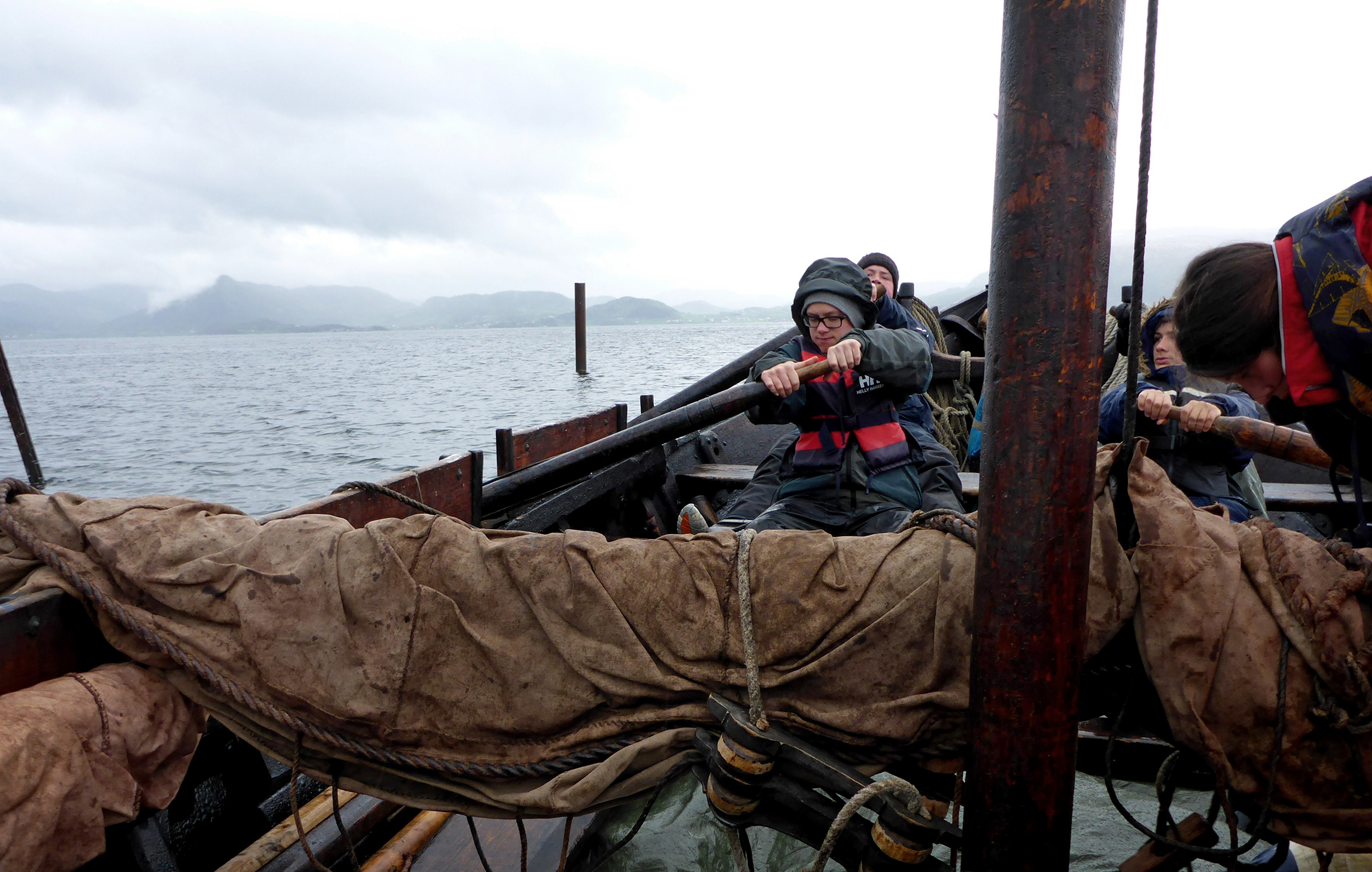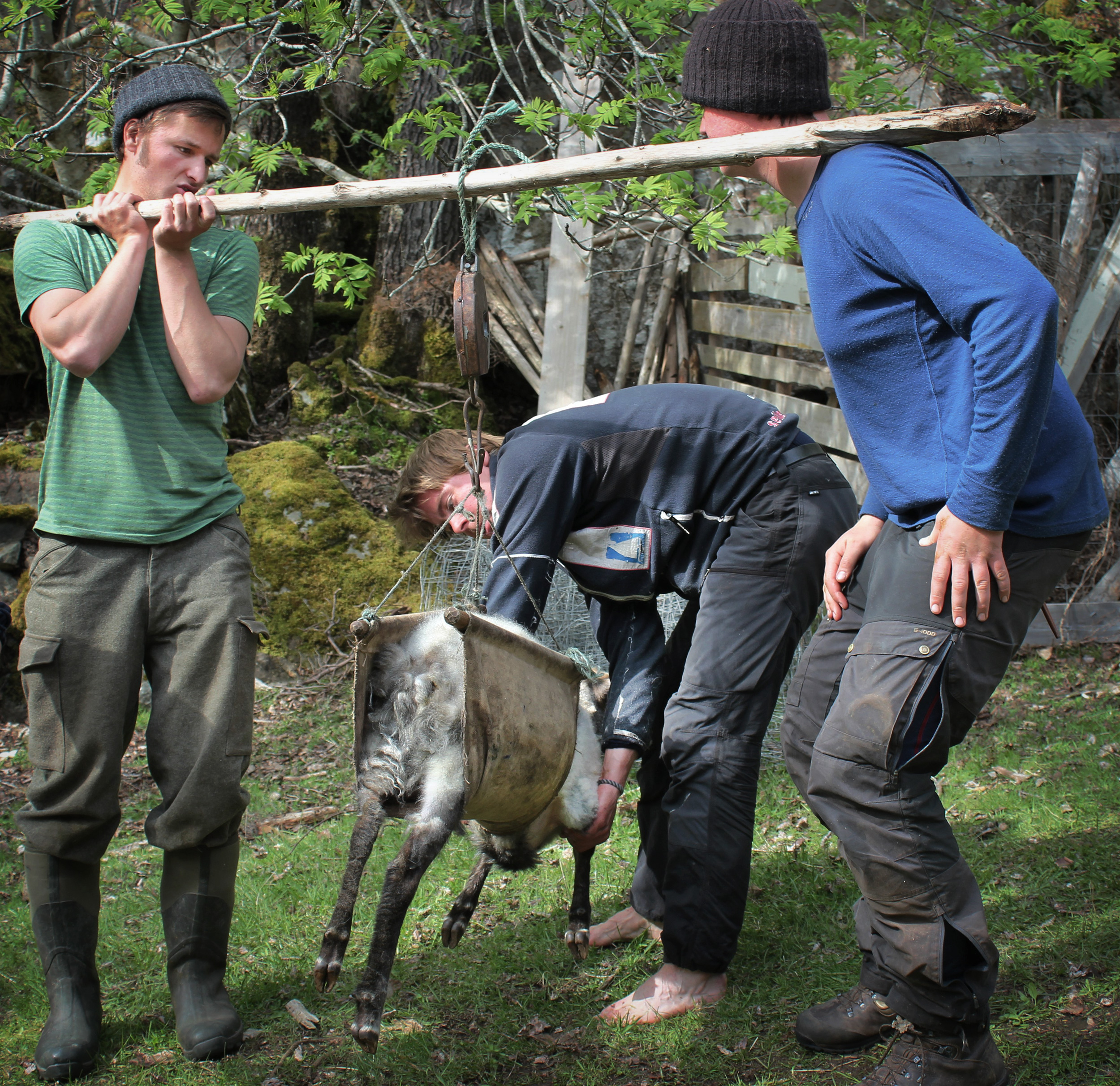No Wool, No Vikings
The fleece that launched 1,000 ships.
Article body copy
Gray clouds hang low over the Trondheim Fjord, a huge, convoluted indentation in the central Norwegian coast. A gusting wind blows the tops off the waves, tosses rain in my face, and fills Braute’s great square sail. It heels over, water splashing over its leeward gunwale and through the oar-ports, soaking everyone on that side of the long, open, Viking-style wooden boat.
Braute is sailing out from Fosen Folk High School, located in Rissa, on the north shore of the fjord. I’m sharing a hard wooden bench with some of the school’s students—mostly young Norwegians, with a sprinkling of foreigners. They’ve just spent nine months studying traditional skills that date back to the Viking Age, from boatbuilding and sailing to traditional farming and wool working.
On this, the last trip of the school year, we’re heading for Utsetøya, a little island near the mouth of the fjord. That’s where the school’s small flock of sheep, which provides both meat and wool, runs wild for most of the year, hemmed in only by the sea. Most of Fosen’s student body is crammed aboard Braute and two other Viking-style boats, along with staff, food, mounds of camping gear, and one shivering Canadian journalist. The plan is to camp on the island for several nights, check on the flock, and collect next year’s supply of raw wool.
It’s the end of May, but it’s cold. Viking life must have been like this—frigid, wild days in an open boat, constantly watching the waves and clouds to avoid disaster. Wool was as much a part of that life as the sea and the ships. The Vikings were great sailors and fearsome warriors, but they couldn’t have left port without wool. It provided the raw material for their clothes, their blankets, even the sails that harnessed the wind for their ships.
A desire to understand the role of wool in Viking life and culture—and in their pursuit of land and wealth as far abroad as Constantinople and Newfoundland—has drawn me to Norway. Braute, built in the tradition of a 17th-century fishing boat, not much different from the boats the Vikings sailed, may be my best chance to experience Viking life—both the wild and the wooly.
Normally, it’s a one-day sail to Utsetøya, but we’ve been beating into the wind for hours, and we’re still less than halfway there. Marius Langeland, the sailing teacher, is eyeing his charts and the waves. Slim, athletic, and 30-something with floppy, sun-bleached hair, Langeland is—I’ve been assured—one of the best square-sail sailors in Norway. Right now, he doesn’t look happy.
Time to tack. Langeland shouts a command, and student-sailors scramble to their stations. One group loosens the ropes that secure the sail’s port corner near the bow, and a second group loosens the ropes tying its starboard corner to the stern. Langeland barks a second command, and the students flip the angle of the sail, tying the port corner to the stern and the starboard corner to the bow, so that Braute can catch the wind from its other side. After a minute or so of hauling on ropes to pull the sail taut, we’re slogging into the blustery wind again.
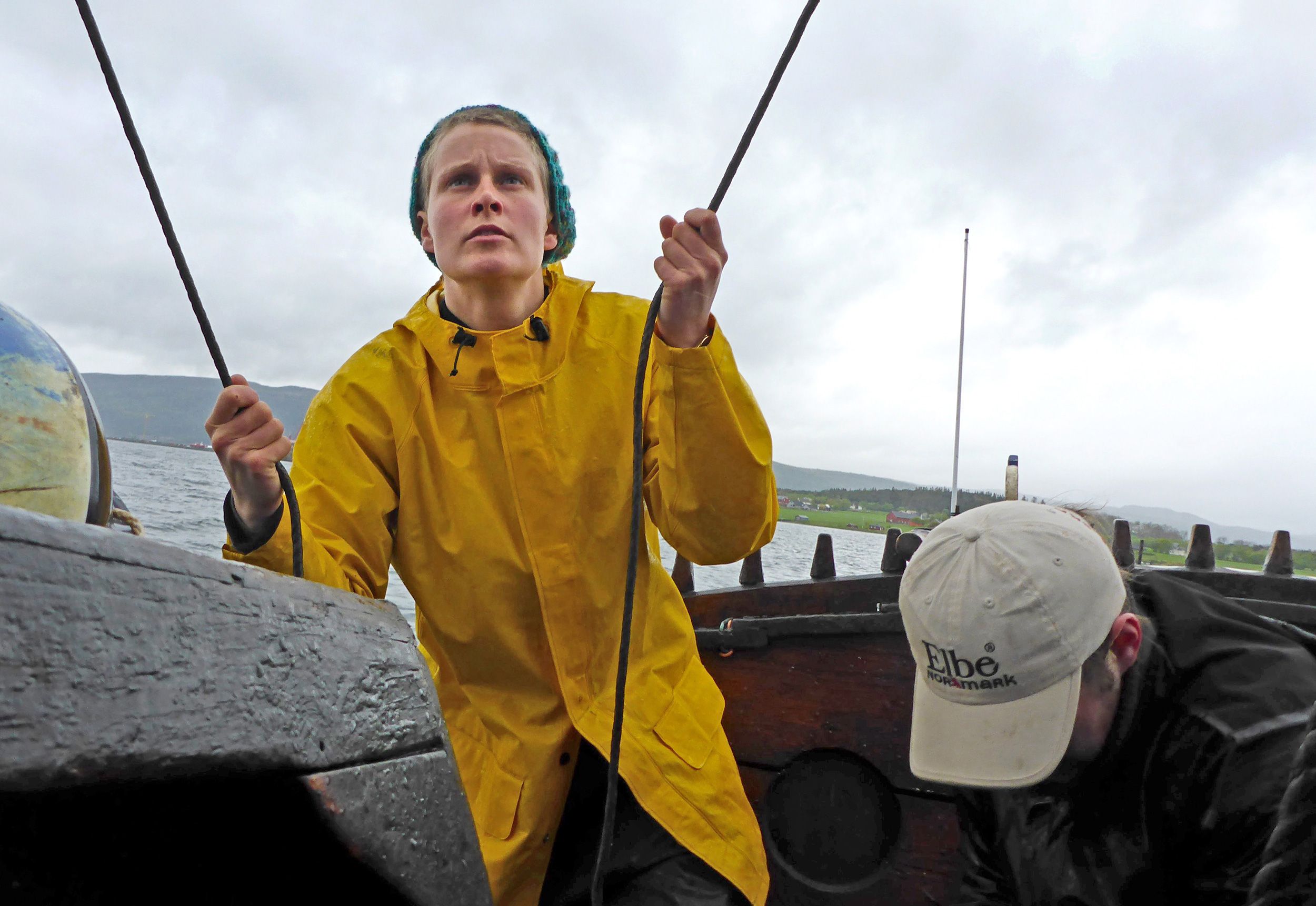
Sailing student Kirstine Schøler Hjort controls the angle of the sail as Braute tacks. Photo by Claire Eamer
Huddled on the drier side of the boat, I look around for echoes of Viking life. It’s amazing how much of what’s happening is about, driven by, or even just protected by wool. The trip itself is all about the school’s sheep. They’re similar to the ones the Vikings kept: northern European short-tailed sheep. Tough little animals, no bigger than a large dog, they can live virtually wild off the harsh land that surrounds the North Atlantic. Their wool has kept the Vikings, their ancestors, and their descendants warm and dry for millennia.
It’s still keeping us warm today on Braute. Laila Sandsaunet, who grew up in Thailand and feels the cold, has a red woolen hat pulled down to her eyebrows and hand-knitted red mittens over purple felted wrist warmers. Slim, intense Kirstine Schøler Hjort, sharing tiller duties with Langeland, wears a turquoise toque with a pointed top. Woolen socks stick up from the tops of boots, and heavy woolen pullovers are barely visible under rain jackets. I’m a United Nations of wool myself with my Peruvian alpaca wool toque, Scottish lambswool pullover, and long underwear furnished by a merino somewhere in New Zealand.
Our woolen wardrobes are skimpy by Viking standards. During the Viking heyday—roughly 700 to 1100 CE—the sailors would have donned tightly woven woolen cloaks, possibly covered by oil; waterproof leather (oilskins) to keep out the damp; and woolen tunics, leggings, socks, mittens, and hats, either woven or constructed by nålebinding, a kind of single-needle knitting. Knitting, as we know it, wasn’t common in northern Europe until after the Viking Age. The luckier crewmembers might have slept under sjøryas, thick blankets knotted like hooked rugs.
Wool provides warmth even when it’s wet. The key is kink: wool fibers have regular crimps. When they’re spun into yarn, the kinks don’t quite match up, trapping pockets of insulating air. The fibers themselves have an outer layer of tiny scales coated with lanolin, a waxy substance that repels moisture and preserves the air pockets. The scales overlap like shingles, locking and tangling together, making the surface even more water-repellent.
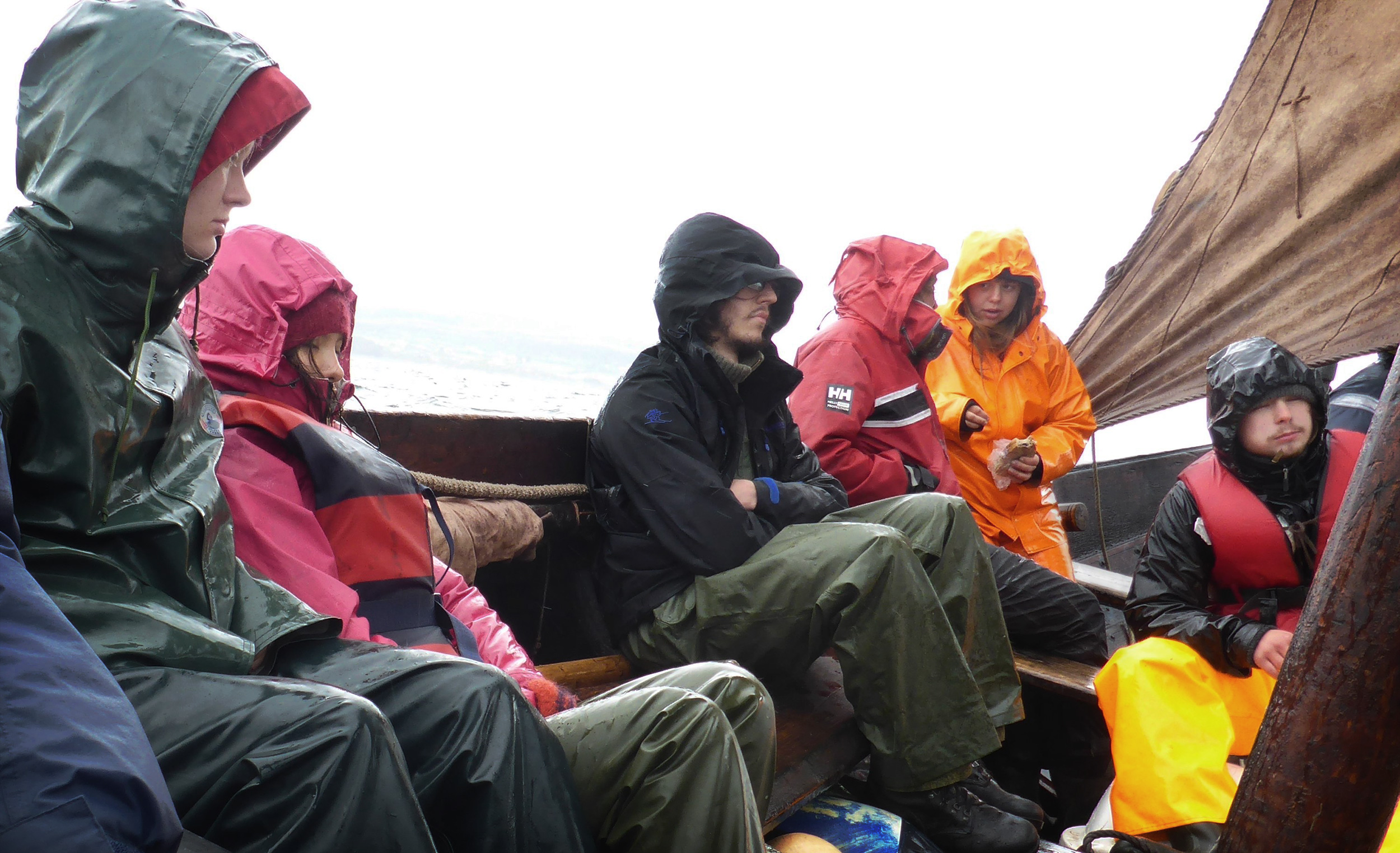
Fosen Folk High School students try to keep warm while sailing on Trondheim Fjord. Photo by Claire Eamer
And wool has another advantage for people who spend weeks or months at sea. It doesn’t need much cleaning. As Norwegian textile archaeologist Lise Bender Jørgensen told me in an email interview, airing and a bit of rinsing might be all the cleaning it needs, even after weeks at sea.
Keeping sailors warm and dry is just part of the story of Viking wool. Braute was constructed in 1994 in the style used by Norwegian fishermen and traders since the Viking Age. Its hull is built of overlapping planks, the wood darkened by more than 20 years of tarring and oiling. At 12.8 meters long, it’s about half the length of some of its big sisters, the longships that once sailed across open oceans. Its square linen sail hangs from a single mast. Braute smells of seawater, wood, wet hemp, tar, and a hint of plastic from the bright-orange tarps covering the higgledy-piggledy pile of camping gear amidships. Once a boat like Braute would also have smelled of wet wool. As recently as a couple of centuries ago, that sail could have been woolen—dense cloth woven on looms in small, dark cottages strung along coasts once dominated by the Vikings. Meter upon meter of fabric was painstakingly woven in strips and sewn together. Outfitting a single warship about twice as long as Braute and its crew might have required the wool of 1,000 sheep or more.
All that wool! It took land and farming skills to raise the sheep that supplied the wool, and a support network of (mostly) women whose spindles and looms produced the cloth. Textile archaeologist Jørgensen says the introduction of sails must have greatly increased the demand for wool and grazing land. Norway-based historical textile researcher Amy Lightfoot has even speculated that the demand for pastureland might have driven the Viking expansion as much as the gleaming temptations of stolen treasure and legitimate trade. Clearly the classic image of wild-haired Viking warriors isn’t the whole story.
Langeland has been talking on his cell phone to the other two boats in our small fleet. (Cell service: that’s a luxury the Vikings would have appreciated.) He tucks the phone away in his pocket. There’s a gale warning for the outer fjord, the stretch of sea that lies between Utsetøya and us. We’re going to take shelter for the night in a small, protected harbor. He calls for another tack, and his chilled crew scrambles to align the heavy sail again.
Until recently, many historians thought that what we’re doing—sailing into the wind—was impossible for Viking boats with their square sails; they believed that the boats could only sail with the wind behind them. However, Langeland and others have demonstrated that square sails can indeed sail into the wind, if not as efficiently as triangular sails. But what about woolen sails? Surely woven wool would leak too much air for efficiency. How did the Vikings turn wool into functional sailcloth?
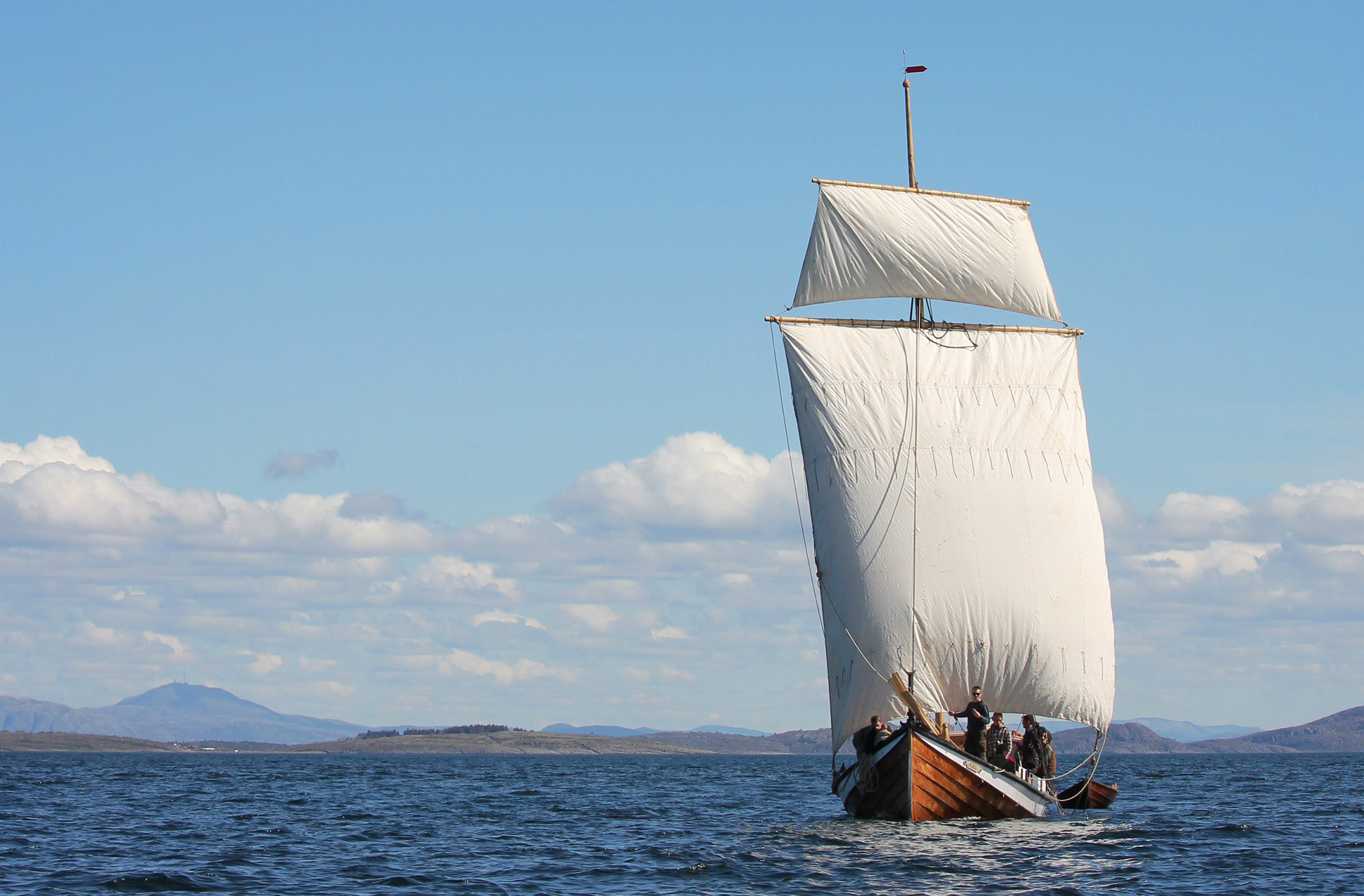
Today, boats such as Fri sport linen sails, but in Viking times the sails were likely woolen. Photo by Claire Eamer
In 1989, workers repairing the roof of a medieval church in Trondenes in northern Norway found pieces of 600-year-old woolen sailcloth stuffed into the attic. While it dates from about three centuries after the height of the Vikings’ dominance, it belongs to the same sailing tradition. Chemists, historians, textile experts, and archaeologists have pored over the chunk of fabric. They learned it was a variation of wadmal, the basic woolen cloth woven for everyday use throughout the North Atlantic region, from Viking days right through the Middle Ages. The wool itself came from northern European short-tailed sheep—the kind the Vikings kept. Jørgensen says their unusual coat was a key element in making woolen sails.
The sheep are double-coated, with an outer coat of long, strong guard hairs and a soft, warm inner coat. Both kinds of fiber showed up in the old sail. To create a strong fabric, the weaver used the coarse outer hairs in the sail’s warp (vertical fibers on a traditional warp-weighted loom). The weft (horizontal fibers) came from the soft inner coat that fluffs out a bit, filling the gaps in the weave. The finished material was “fulled”—that is, treated to shrink it slightly and tighten the fabric.
But that wasn’t the whole secret of a windproof woolen sail. Analysis showed that the sail fragment was soaked with resinous material. After centuries crammed between the joists of the old church, it was almost as stiff as the boards that protected it. That goopy stuff proved to be crucial to making a functional woolen sail.
Amy Lightfoot has made several woolen sails based on that old cloth. For someone curious about Vikings and wool, she’s the Holy Grail—and, sadly, just as hard to reach. She lives on a remote island, not far from Utsetøya, with no public transportation and not much phone access.
I had to settle for her written account of creating a woolen sail. An important step, she wrote, was recreating the resinous goo found in the old sail. She smeared her sails with a combination of fir tar, fish oil, and sheep tallow—all easily available 600 years ago. It worked. Her sails repel water and have substantial wind resistance.
But they need a mind-boggling quantity of wool. Based on her first sail, Lightfoot estimated that a 100-square-meter sail (about one-quarter the size of a basketball court and big enough for a 30-meter longship) used two tonnes of fleece, the annual production of about 700 sheep. Researchers at the Viking Ship Museum in Roskilde, Denmark, calculated that by the mid-11th century, the Viking fleet—fishing boats, coastal traders, cargo ships, and longships—carried roughly one million square meters of sail, requiring the equivalent of all the wool produced in one year by about two million sheep.
The amount of wool working is just as mind-boggling as the amount of wool. “It’s actually more time-consuming to produce the textiles than to produce the boat,” Lightfoot said in a 2009 documentary about woolen sails. Building a boat might take two skilled boatbuilders a couple of weeks, she estimated, but creating its sail would take two skilled women a year.
Langeland has sailed several Viking-style ships equipped with woolen sails, and there’s nothing inferior about the material itself, he says. How well the sails work depends on the skill of the sailmaker. He also says that we might be overestimating the technology required for the Viking voyages.
“You could easily get across the North Atlantic with crappy sails,” he says, leaning back against Braute’s cabin and gazing up at its efficient linen sail. “Lots of people have done it.”
Late in the afternoon, we pull into a small, sheltered harbor. The gale warning has evaporated, the rain has almost stopped, and the gusty wind is down to a breeze. I’m still cold, and I’m pretty sure that a Viking life is not for me. But the next morning has me reconsidering.
We set out on the second leg to Utsetøya under clear skies, warm sunshine, and a gentle breeze. Sea and sky are a startling blue. Most of us sprawl on deck, still wrapped in wool but enjoying the warmth. Langeland sheds his shirt and leans, bare-chested, against the stern cabin, the tiller held lightly in one hand. The largest boat in our small fleet, Fri, closes up behind us and then passes, presenting a picturesque profile. Braute probably looks just as elegant and romantic to them, I think. Maybe the Viking life wasn’t so bad after all.
By midday, all three boats have arrived at Utsetøya. It’s time to chase sheep!
Most modern domestic sheep are burly creatures, bred for the maximum meat or wool. They need tending: shearing, protecting, and extra feeding in winter. Not so the northern European short-tailed sheep. They’re about half the size of most other breeds, and they’re tough, requiring only occasional extra feeding in winter.
“They can live all year-round in the coastal heathlands, feeding on heather, seaweeds, et cetera,” said textile historian Bender Jørgensen. “Similar sheep were common all around the North Atlantic—for example, the Faroes, Iceland, Orkneys, Shetlands.”
They probably derive from a common stock, she said, but they’ve developed into a number of regional subspecies over time. And there’s been plenty of time. On Scotland’s Orkney Islands, archaeologists have found evidence of domesticated sheep dating back about 5,000 years.
A few days before joining Braute, I was on North Ronaldsay, the northernmost of the Orkney Islands, where the local sheep have evolved into the ultimate coastal breed. Almost two centuries ago, the islanders built a stone dike a little way above the high tideline to confine the sheep to the shore and preserve the few small fields for crops and cattle. Since then, North Ronaldsay sheep have lived mainly on seaweed, picking their way over slick rocks and browsing on the wet algae exposed at low tide. They’re so well-adapted that if you restrict them to a standard grassy diet, they’re likely to sicken and die.
The Utsetøya sheep snack on seaweed, too, says Ingvar Øydvin, but their main diet is the tough heather that covers the island’s rocky hills. Øydvin, middle-aged and lanky with shoulder-length graying hair, is in charge of the school’s flock and activities on Utsetøya. Right now, it’s roundup time.
We’ve set up camp in a V-shaped green valley that opens out to the sea. At the narrow top of the valley is an open storage shed and a rough wooden pen. Under Øydvin’s direction, the students haul weathered posts and well-used lengths of wire fencing out of the storage shed and construct a temporary run to funnel the sheep into the pen. One side of the run is the makeshift fence, and the other is the steep valley wall.
Øydvin sends some of the students and teachers over the hills to herd the flock toward the run. He posts the rest of us at any point where the sheep might make a break for freedom. Within 20 minutes, the first ewes and lambs show up, chased by exuberant students who have just spent two days cooped up on small boats. Langeland and a couple of young men are the last to return, cradling a lamb with an eye injury.
Within half an hour, the sheep are in the pen, bleating in every range from baritone to high soprano. Last fall, the flock totaled 22 pregnant ewes. Today, the students have rounded up all 22 ewes plus 28 lambs—enough to fill the small pen to capacity. When I point my camera between the slats of the pen, a large ewe glares through the lens in haughty disdain. The sheep are not pleased.
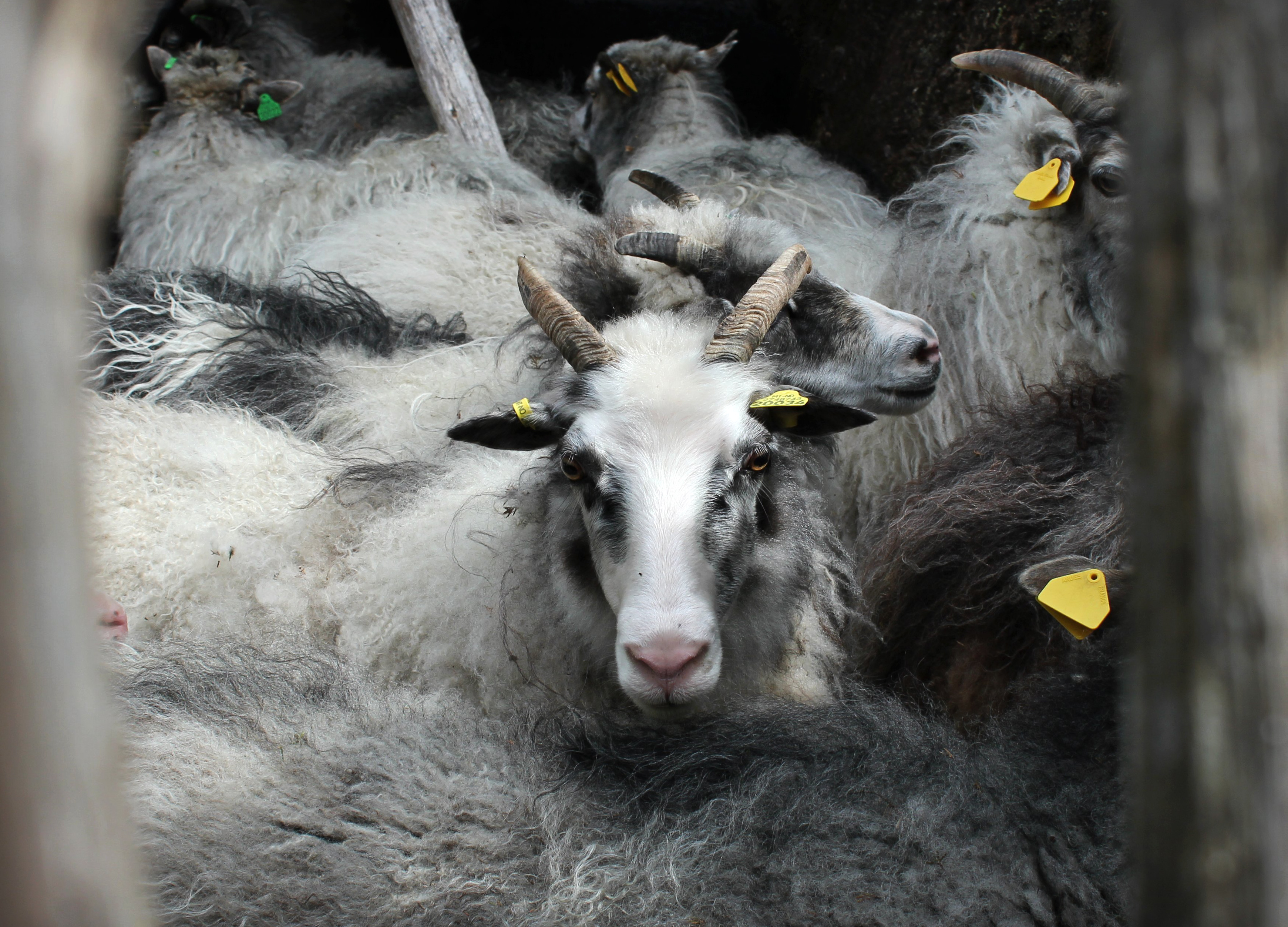
A disgruntled ewe stares between the boards of Fosen Folk High School’s holding pen on Utsetøya. Photo by Claire Eamer
And it’s about to get worse, from a sheep’s point of view. Every ewe will be weighed, checked for any health issues, and dosed against ticks and parasites. Every lamb will be sexed, dosed, and marked with ear tags. All the information is methodically recorded.
But first, it’s time to collect the wool. These double-coated sheep shed their wool naturally in late spring and summer, so they don’t need to be shorn. Instead, the wool is plucked, or “rooed”—a bit like pulling loosened hair from a shedding dog. Rooing is labor intensive. In Viking times and for centuries after, the whole village would join in the roundup and rooing. The captive labor force of Fosen students means rooing is still possible on Utsetøya.
The ewes are removed from the pen one at a time. Two people grab a ewe and straddle it, one holding onto its short, slightly curved horns and the other clinging to the wool of its back. They march the ewe to the edge of a big blue tarp and lay it on its side. Four or five rooers sit in a circle, pulling steadily on handfuls of wool until it comes loose and piling the wool on the tarp. When I try rooing, the wool feels oily and gritty with sand and salt accumulated in the year since the last rooing. I have to pull harder than I expected, but the wool comes loose without a flinch from the ewe.
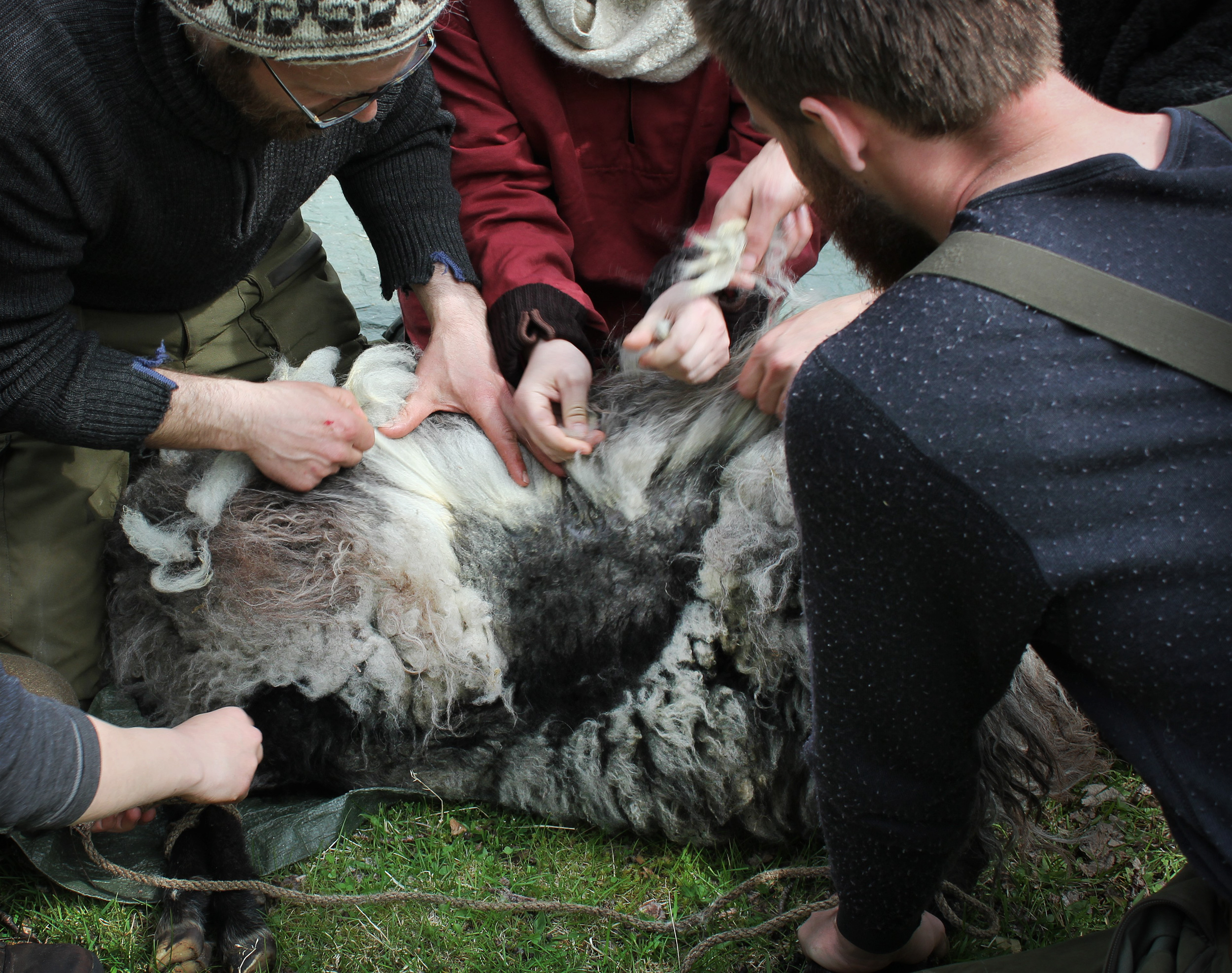
Students “roo” a sheep by gripping the wool and tugging out handfuls. Vikings would have used this method of gathering wool. Photo by Claire Eamer
Øydvin moves from group to group, pausing occasionally to cut through felted mats of wool with clippers. Even with four or five people per ewe, rooing 22 sheep takes several hours. The rooed ewes look a bit naked, with their new undercoats just growing in. However, their complaints appear to be more about offended dignity than discomfort. There’s also a constant battery of loud baas from ewes calling to their lambs and lambs calling for their mothers.
Finally, it’s over and the flock is released. They bound away from the holding pen, shouting rude sheep sounds at the humans, free to be wild sheep for another six months until the next roundup. But this is just the beginning for the humans. Before those piles of gritty wool can become mittens or blankets, there are months of work ahead: sorting, washing, carding, spinning, dyeing, and finally weaving or knitting.
The Utsetøya sheep don’t know it, but the heyday of their breed is over. Big sheep with big wool—such as merinos or Lincolns—dominate the market today, providing huge quantities of fiber that go mostly to home furnishings and mass-produced garments. Small sheep with odd double coats just don’t make the grade.
But wool itself is making a comeback. It was once the go-to fiber of poor farmers, fishermen, and Viking raiders, but today it’s fashionable. In the 1980s, the successful “Cool Wool” marketing campaign from Australian wool growers tried to snatch back the market share that wool had lost to synthetic fleece, promoting wool for designer clothing and elite business wear. Now lightweight, non-scratchy merino wool is popular with the outdoor leisure crowd. My merino long johns, apparently, are trendy. Not long ago, researchers found that laundering synthetic fleece floods aquatic ecosystems with tiny plastic microfibers, which made wool look even better in comparison. New ad campaigns for major wool brands also tout wool, with its relatively low carbon footprint, as the greener way to dress outdoors.
Back in the old Viking lands, northern European short-tailed sheep still help some small communities survive. The collective that manages North Ronaldsay’s seaweed-munching sheep bought a small woolen mill and now ships specialty yarns around the world. Tourists visiting Iceland often return home with traditional yoke-patterned hand-knitted sweaters. The sweater tradition actually began in the 1950s, but the wool comes from sheep a Viking would recognize.
Meanwhile on Utsetøya, the rain is back and the forecast is bad. School staff members are cutting the trip short, and loading the boats for the voyage home. I hitch a ride on Fri, since it’s stopping at an island where I can catch a ferry back to Trondheim.
After living on Braute through cold wind and rain, I have a new appreciation of wool’s close relationship to survival on the stormy northern seas. I try to imagine the Vikings, a rugged, cold-dwelling people, leaving their mark on the northern world without wool. I can’t.
I exchange farewell waves across the water with Langeland, Sandsaunet, Schøler Hjort, and the rest of the crew, who are stowing the wool in Braute’s small cabin. A year from now, textile arts students will have transformed it into hats and mittens, pullovers and blankets, tapestries and skeins of colorful yarn.
As Utsetøya recedes behind us, I wonder if I can get hold of a few skeins of Fosen yarn in the spring. A scarf or hat knitted from the wool of a sheep I’ve actually met, face to muzzle … now that would be something special.


